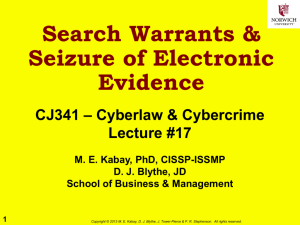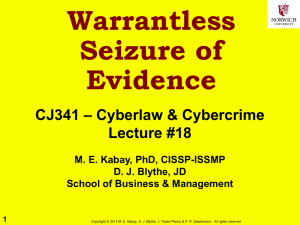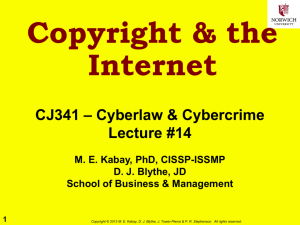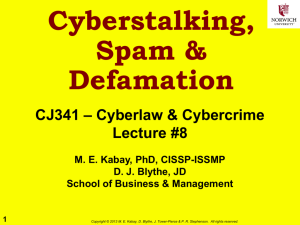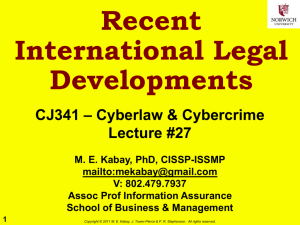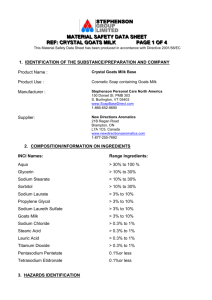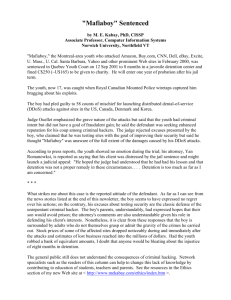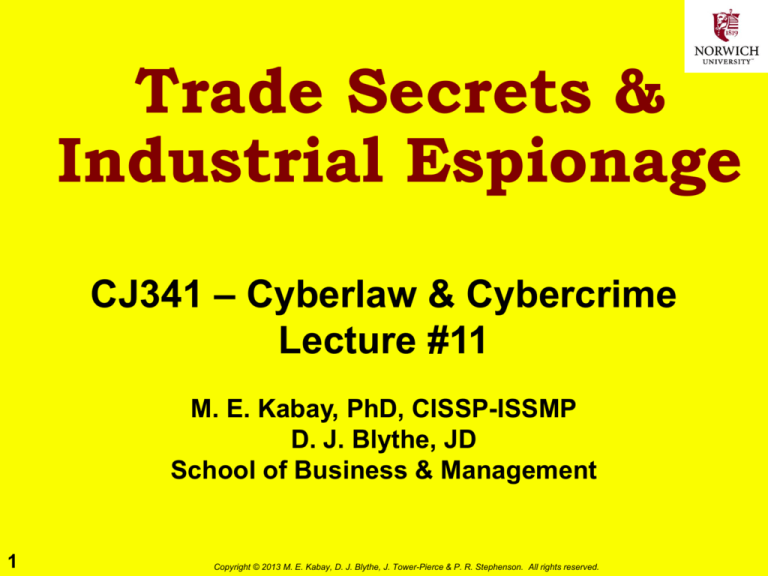
Trade Secrets &
Industrial Espionage
CJ341 – Cyberlaw & Cybercrime
Lecture #11
M. E. Kabay, PhD, CISSP-ISSMP
D. J. Blythe, JD
School of Business & Management
1
Copyright © 2013 M. E. Kabay, D. J. Blythe, J. Tower-Pierce & P. R. Stephenson. All rights reserved.
Topics
Definition of Trade Secrets
Protection
Polices & Law
Damages
International Issues
Industrial Espionage
2
Copyright © 2013 M. E. Kabay, D. J. Blythe, J. Tower-Pierce & P. R. Stephenson. All rights reserved.
Definition
“In most states, a formula, pattern, physical device,
idea, process, compilation of information or other
information that
1. provides a business with a
competitive advantage, and
2. is treated in a way that can
reasonably be expected to
prevent the public or
competitors from learning
about it, absent improper acquisition or theft.”*
Sometimes referred to as confidential information or
proprietary knowledge
See also Burgunder p. 212
3
_____
* http://www.nolo.com/dictionary/trade-secret-term.html
Copyright © 2013 M. E. Kabay, D. J. Blythe, J. Tower-Pierce & P. R. Stephenson. All rights reserved.
Purpose of Trade Secret
Laws
Protect valuable creative ideas
at various stages of
development
Patents cover completed
inventions & processes
Require inventions be
novel and
Nonobvious
Trade secrets require only
information be valuable
4
Copyright © 2013 M. E. Kabay, D. J. Blythe, J. Tower-Pierce & P. R. Stephenson. All rights reserved.
Misappropriation Defined
Trade secret holder entitled to remedies when misappropriation
occurs:
Acquiring trade secret by improper means
Disclosing or using trade secret reasonably knowing that such
conduct violates duty to maintain
confidence
While reasonably knowing of
impropriety, using or disclosing secret
received from another who improperly
obtained it
While reasonably knowing about
fiduciary breach, using or disclosing
secret that was disclosed by another
under such a duty to maintain
confidence
(See Burgunder p. 213)
5
Copyright © 2013 M. E. Kabay, D. J. Blythe, J. Tower-Pierce & P. R. Stephenson. All rights reserved.
State Laws on Trade Secrets
6
State Level: Most states have separate statutes
criminalizing trade secret theft
American Law Institute (ALI)
1995: Restatement (Third) of Unfair
Competition
National Conference of Commissioners on
Uniform State Laws
1979: formulated
UTSA
Uniform Trade Secrets Act
Model for state legislatures to follow to pass
statutes that codify policies
By 2005, 44 states & District of Columbia had
statutes based on UTSA
Copyright © 2013 M. E. Kabay, D. J. Blythe, J. Tower-Pierce & P. R. Stephenson. All rights reserved.
Trade Secret Policies & Law
Formula
Pattern
Compilation
Program
Device
Method
Technique
Process
Uniform Trade Secrets Act (UTSA)
Information
Derives independent economic value
from secrecy
Subject of reasonable efforts
to maintain secrecy
Contrast with patent (“patent” means “open”)
Unauthorized use of trade secret can lead to
civil tort for misappropriation
7
Copyright © 2013 M. E. Kabay, D. J. Blythe, J. Tower-Pierce & P. R. Stephenson. All rights reserved.
UTSA Remedies for
Misappropriation
Damages ($)
Amount needed to compensate the
trade secret holder for losses
Amount of unjust enrichment
earned by unlawful use or
disclosure
Injunctions
Preventing use
Including “threatened
misappropriation”
To obtain preliminary injunction,
must prove:
Irreparable harm
Strong likelihood of success of
winning if case goes to trial
8
Copyright © 2013 M. E. Kabay, D. J. Blythe, J. Tower-Pierce & P. R. Stephenson. All rights reserved.
Borland & Symantec 1992
Eugene Wang
Former CEO of Borland Int’l
Resigned 2 months after
management shuffle
Became VP of Symantec
Borland officials searched his e-mail
Found files sent via MCI Mail
10 msgs to Symantec CEO
Contained confidential info
Borland filed civil & criminal
charges
Scotts Valley Police Department
Provisions of CA penal code applied
9
http://catless.ncl.ac.uk/Risks/13.87.html#subj2
Copyright © 2013 M. E. Kabay, D. J. Blythe, J. Tower-Pierce & P. R. Stephenson. All rights reserved.
Microsoft and Google (2000):
Non-Compete Clause
Microsoft hired Kai-Fu Lee
VP for R&D
Lee agreed if he left Microsoft
he wouldn’t work for 1 year in
competitive capacity
Quit and worked as head of
Google China
TRO (temporary restraining order) issued
Dispute eventually settled
UTSA – Civil provisions
Doesn’t authorize government to bring criminal
actions
Some states have separate criminal statutes for
trade secret theft
10
Copyright © 2013 M. E. Kabay, D. J. Blythe, J. Tower-Pierce & P. R. Stephenson. All rights reserved.
Federal Level
Trade Secrets Act (18 USC §1905)
http://www.law.cornell.edu/uscode/html/us
code18/usc_sec_18_00001905----000-.html
Economic Espionage Act (18 USC §1831 et
seq.)
http://www.law.cornell.edu/uscode/html/us
code18/usc_sec_18_00001831----000-.html
http://www.law.cornell.edu/uscode/
11
Copyright © 2013 M. E. Kabay, D. J. Blythe, J. Tower-Pierce & P. R. Stephenson. All rights reserved.
(Federal) Trade Secrets Act
18 USC §1905
Covers
Unauthorized disclosure
Of secrets relevant to
government work
Contracts
Investigations
Reports
By government employee
or agent only
Text on next slide
12
Copyright © 2013 M. E. Kabay, D. J. Blythe, J. Tower-Pierce & P. R. Stephenson. All rights reserved.
Trade Secrets Act (Text)
Whoever, being an officer or employee of the United States or of
any department or agency thereof, any person acting on behalf of
the Office of Federal Housing Enterprise Oversight, or agent of the
Department of Justice as defined in the Antitrust Civil Process Act
(15 U.S.C. 1311–1314), or being an employee of a private sector
organization who is or was assigned to an agency under chapter
37 of title 5, publishes, divulges, discloses, or makes known in any
manner or to any extent not authorized by law any information
coming to him in the course of his employment or official duties or
by reason of any examination or investigation made by, or return,
report or record made to or filed with, such department or agency
or officer or employee thereof, which information concerns or
relates to the trade secrets, processes, operations, style of work,
or apparatus, or to the identity, confidential statistical data,
amount or source of any income, profits, losses, or expenditures
of any person, firm, partnership, corporation, or association; or
permits any income return or copy thereof or any book containing
any abstract or particulars thereof to be seen or examined by any
person except as provided by law; shall be fined under this title, or
imprisoned not more than one year, or both; and shall be removed
from office or employment.
http://www4.law.cornell.edu/uscode/html/uscode18/usc_sec_18_00001905----000-.html
13
Copyright © 2013 M. E. Kabay, D. J. Blythe, J. Tower-Pierce & P. R. Stephenson. All rights reserved.
Economic Espionage Act of
1996 (EEA)
18 USC §1831 et seq.
Criminalizes unauthorized
disclosure of government
OR commercial secrets by
anyone
Includes penalties for
those receiving such
information
See text on next slide
14
Copyright © 2013 M. E. Kabay, D. J. Blythe, J. Tower-Pierce & P. R. Stephenson. All rights reserved.
EEA Text
§ 1831. Economic espionage
(a) In General.— Whoever, intending or knowing that the offense will benefit
any foreign government, foreign instrumentality, or foreign agent,
knowingly—
(1) steals, or without authorization appropriates, takes, carries away, or
conceals, or by fraud, artifice, or deception obtains a trade secret;
(2) without authorization copies, duplicates, sketches, draws,
photographs, downloads, uploads, alters, destroys, photocopies,
replicates, transmits, delivers, sends, mails, communicates, or
conveys a trade secret;
(3) receives, buys, or possesses a trade secret, knowing the same to
have been stolen or appropriated, obtained, or converted without
authorization;
(4) attempts to commit any offense described in any of paragraphs (1)
through (3); or
(5) conspires with one or more other persons to commit any offense
described in any of paragraphs (1) through (3), and one or more of
such persons do any act to effect the object of the conspiracy, shall,
except as provided in subsection (b), be fined not more than $500,000
or imprisoned not more than 15 years, or both.
(b) Organizations.— Any organization that commits any offense described in
subsection (a) shall be fined not more than $10,000,000.
15 http://www4.law.cornell.edu/uscode/html/uscode18/usc_sec_18_00001831----000-.html
Copyright © 2013 M. E. Kabay, D. J. Blythe, J. Tower-Pierce & P. R. Stephenson. All rights reserved.
EEA Penalties Include
Up to 15 years in jail
MAX($500,000 fine or 2x value)
Forfeiture
Import-export
restrictions
16
Copyright © 2013 M. E. Kabay, D. J. Blythe, J. Tower-Pierce & P. R. Stephenson. All rights reserved.
First Amendment Issues
Opponents of corporate actions have revealed
trade secrets to press
Concerned or disgruntled
employees
Journalists or activists using
social engineering (e.g.,
Ciarelli)
Can corporations impose prior
restraint to prevent publication?
Generally, no: 1st Amendment
protects such publication
absent compelling reasons to interfere
May still prosecute for industrial espionage after
the fact
17
Copyright © 2013 M. E. Kabay, D. J. Blythe, J. Tower-Pierce & P. R. Stephenson. All rights reserved.
Apple Corp vs Bloggers (1)
Nicholas Ciarelli became fond of Apple MAC at age 6
At age 13, founded Think Secret Web site
Focused on Apple products
Popular venue for news, reviews, gossip & rumors
Pen-name “Nick dePlume”
In late Dec 2004, Think Secret
previewed new products before
Apple ready to announce them
Mac mini
iPod Shuffle
iLife ’05 & GarageBand 2
Lawsuit Jan 2005: Apple
Computer Inc v. Nick dePlume
18
See http://www.wired.com/wired/archive/13.05/apple.html
Copyright © 2013 M. E. Kabay, D. J. Blythe, J. Tower-Pierce & P. R. Stephenson. All rights reserved.
Apple vs Bloggers (2)
Also launched separate lawsuit vs other blogs
v. Think Secret, PowerPage.org &
AppleInsider
Demanding identity of insiders who leaked info
Lawyer Terry Gross of Gross & Belsky took case
Pro bono
Demanded dismissal
Labelled case a SLAPP (Strategic Lawsuit Against
Public Participation)
Denied that any significant trade secrets were
revealed at all
19
See http://www.wired.com/news/mac/0,2125,66821,00.html
Copyright © 2013 M. E. Kabay, D. J. Blythe, J. Tower-Pierce & P. R. Stephenson. All rights reserved.
Apple vs Bloggers (3)
Mar 2005: EFF (Electronic Frontier Foundation, eff.org)
Filed amicus curiae (friend of the court) brief in favor
of defendants
Argued online journalists
should have same rights as
traditional journalists
Mar 2005: CA Superior Court
judge James Kleinberg ruled
bloggers had no right to protect
sources
“…an interested public is not the same as the public
interest.”
EFF warned “"Anyone who reports on companies or
the trade press should be concerned about this
ruling."
See http://news.bbc.co.uk/2/hi/technology/4348425.stm
20
Copyright © 2013 M. E. Kabay, D. J. Blythe, J. Tower-Pierce & P. R. Stephenson. All rights reserved.
DeCSS Trade Secret Dispute
1999: 15 year old Norwegian Jon Lech Johansen
Studied DVD Software Player
Determined how CSS anti-copy system worked
Ascertained encryption keys to descramble CSS
protection
Posted DeCSS software on Internet
5 years of litigation involving DMCA;
issues:
Reverse engineering,
Injunctive relief
Misappropriation
Acquitted (twice) in Norway in 2003
See Burgunder pp 230-234
21
Copyright © 2013 M. E. Kabay, D. J. Blythe, J. Tower-Pierce & P. R. Stephenson. All rights reserved.
Reverse Engineering
Defined in Computer Desktop Encyclopedia:
To isolate the components of a completed system.
When a chip is reverse engineered, all the individual
circuits that make up the chip are identified. Source
code can be reverse engineered into design models
or specifications. Machine language can be reversed
into assembly language (see disassembler).
Applicability to discussion of trade secrets
Ethical considerations
State trade secret law
(misappropriation
prohibitions) v. acquisition
of info through reverse
engineering
22
Copyright © 2013 M. E. Kabay, D. J. Blythe, J. Tower-Pierce & P. R. Stephenson. All rights reserved.
International Trade Secret
Protection
TRIPS agreement
Agreement on Trade-Related Aspects of
Intellectual Property Rights
Members of the World Trade Organization
(WTO) must protect “undisclosed
information”
Does not use trade secret term
WTO members required to enforce their own trade secret laws
with remedies
Issues
Enforcing contractual obligations / confidentiality agreements
Determining damages
Durational periods – variation in time limits for maintaining
secrecy of info
Need to exercise caution with trade secrets overseas
23
Copyright © 2013 M. E. Kabay, D. J. Blythe, J. Tower-Pierce & P. R. Stephenson. All rights reserved.
Industrial Espionage
Many cases available in
IYIR database
Due to time limitations, will
look only at 2 outstanding
cases:
Echelon
Israeli Trojan Horse
Keylogger
Finish with Chinese
industrial espionage
IYIR: http://www.mekabay.com/iyir/index.htm
24
Copyright © 2013 M. E. Kabay, D. J. Blythe, J. Tower-Pierce & P. R. Stephenson. All rights reserved.
Echelon
EU Parliament attacks Echelon
(2000.07)
Formed temporary committee
to investigate spy network
Suspicions that Echelon
used to intercept
conversations of European
businesses
Information might be given to
competitors from Echelon
operators
US, Canada, Australia,
New Zealand
In 2001.05, report
recommends more use of
encryption to defeat Echelon
25
Copyright © 2013 M. E. Kabay, D. J. Blythe, J. Tower-Pierce & P. R. Stephenson. All rights reserved.
Israeli Trojan Horse Keylogger
2005.05 Suspicions raised by keylogger software on
PCs
Author Amnon Jackont ound his MS on ‘Net
Someone tried to steal money from his bank
Tech found Trojan horse keylogger on computer
Created by Michael Haephrati – ex-son-in-law
Many companies found infected by same program –
sent data to server in London
2006.03 Perpetrators sent to jail
Michael Haephrati: 4 years
Ruth Brier-Haephrati: 2 years
26
Copyright © 2013 M. E. Kabay, D. J. Blythe, J. Tower-Pierce & P. R. Stephenson. All rights reserved.
Industrial Espionage by PRC
Agents
2001: Hai Lin, Kai Xu, & Yong-Qing
Cheng
2001: Junsheng Wang
2002: Seismic Imaging SW Theft
2006: Fei Ye & Ming Zhong
2007: Chi Mak & Family
2009: US Electric Grid
2011: AMSC SCADA
2013: PRC Denies All
27
Copyright © 2013 M. E. Kabay, D. J. Blythe, J. Tower-Pierce & P. R. Stephenson. All rights reserved.
2001: Hai Lin, Kai Xu, &
Yong-Qing Cheng
Chinese nationals
Arrested for stealing software from Lucent
Sold to Datang Telecom Technology Co. of
Beijing
Majority-owned by Govt of PRC
In 2002, charged with further thefts from 4
other US high-tech firms: Telenetworks,
NetPlane Systems, Hughes Software
Systems, & Ziatech.
28
Copyright © 2013 M. E. Kabay, D. J. Blythe, J. Tower-Pierce & P. R. Stephenson. All rights reserved.
2001: Junsheng Wang
Employed by PRC firm Bell Imaging
Technology
Wife worked for Acuson Corp in California
Wang copied documents brought home by
wife
Gave copies to Bell Imaging on trip to PRC
Convicted of theft of trade secrets
29
Copyright © 2013 M. E. Kabay, D. J. Blythe, J. Tower-Pierce & P. R. Stephenson. All rights reserved.
2002: Seismic Imaging SW
Theft
Chinese programmer arrested
Stole software from 3DGeo
Transferred to China National Petroleum Corp
(state-owned)
Jailed in Santa Clara
30
Copyright © 2013 M. E. Kabay, D. J. Blythe, J. Tower-Pierce & P. R. Stephenson. All rights reserved.
2006: Fei Ye & Ming Zhong
Pleaded guilty to economic espionage
On behalf of PRC
Stole trade secrets from
Sun Microsystems &
Transmeta Corp.
Designing competing
microprocessor using
stolen designs
Planned to share profits
with City of Hangzhou &
Province of Zhejiang
Employer’s firm funded through PRC National
Technology Research & Development
Program of China
31
Copyright © 2013 M. E. Kabay, D. J. Blythe, J. Tower-Pierce & P. R. Stephenson. All rights reserved.
2007: Chi Mak & Family
Chinese-born engineer
Admitted passing stolen submarine
propulsion systems information to Chinese
government
Wife, brother & several other relatives
indicted
Brother & sister-in-law stopped at LA Intl
Airport intending to fly to Hong Kong &
Guangzhou, PRC
Luggage contained encrypted disks with
stolen trade secrets
32
Copyright © 2013 M. E. Kabay, D. J. Blythe, J. Tower-Pierce & P. R. Stephenson. All rights reserved.
2009: US Electric Grid
Chinese, Russian & other spies have
penetrated US electric grid
Installed rogue remote-control software
“"The Chinese have attempted to map our
infrastructure, such as the electrical grid,"
said a senior intelligence official. "So have
the Russians.“
Espionage pervasive across USA
Intrusions growing
33
Copyright © 2013 M. E. Kabay, D. J. Blythe, J. Tower-Pierce & P. R. Stephenson. All rights reserved.
2011: AMSC SCADA Code
June 2011: American Superconductor Corp
(AMSC) technicians examined wind turbine in
Gobi Desert (PRC)
Found that client, Sinovel
Wind Group, stole source
code for proprietary SCADA
software
Client stopped buying SW
from AMSC
2/3 of AMSC’s $315M
annual revenue
Company lost most of its
capitalization
40% value in 1 day
Ended with 83% stock loss by Sep 2011
34
Copyright © 2013 M. E. Kabay, D. J. Blythe, J. Tower-Pierce & P. R. Stephenson. All rights reserved.
2013: PRC Denies All Claims
of Cyberespionage
“U.S. Presses Beijing on Corporate
Espionage: White House Develops Strategy to
Encourage China to Halt Alleged
Cyberspying, but Faces Some Fundamental
Obstacles”
By Siobhan Gorman and Danny Yadron
Updated June 7, 2013 10:01 p.m. ET
WASHINGTON—The Obama administration
faces a major impediment in tackling Chinese
cyberspying: It must convince the Chinese
there's a key line between government spying
and corporate spying.…
http://online.wsj.com/news/articles/SB100014
24127887324069104578527323576340846
35
Copyright © 2013 M. E. Kabay, D. J. Blythe, J. Tower-Pierce & P. R. Stephenson. All rights reserved.
Law & Order
Criminal Intent
36
“Scared Crazy” –
Year 5, Episode 9
Centers on trade
secrets
Pay attention to
how company
attempts to
protect them
Notice methods
use to steal
them
Secondary theme is
consequences of
psychological
torture
Copyright © 2013 M. E. Kabay, D. J. Blythe, J. Tower-Pierce & P. R. Stephenson. All rights reserved.
Now go and
study
37
Copyright © 2013 M. E. Kabay, D. J. Blythe, J. Tower-Pierce & P. R. Stephenson. All rights reserved.


